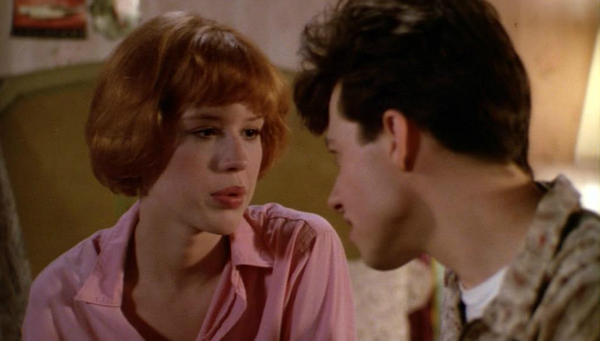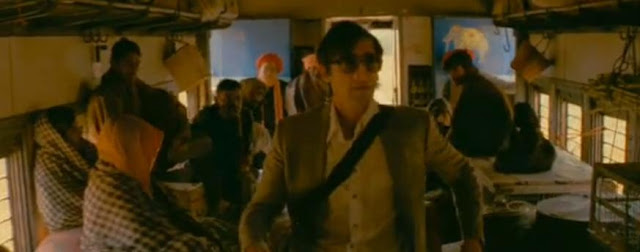This is a guest post by Ingrid Bettwieser and Steffen Loick for our Representations of Female Sexual Desire week.
Girls want relationships, boys want sex. The notion that adolescent girls don’t act on their own sexual desires (and just look sexy) still seems to be a prevailing cultural organizing principle perpetuated by many media illustrations. For us the concept of “Prom” brings together – in a pop-cultural genealogy – diffuse notions of (predominantly) heterosexual teenage desire, depictions of romantic love and binary coupling combined with teen-horrors of social exclusion, acknowledgement and coming-of-age. Prom epitomizes the time and place where sexual subjects/objects of desire are ordered normatively. Individual freedom (not to go to prom but fall out of the place of acknowledgement) and social force (go to prom but subject to normalizing scripts) are negotiated accordingly.
In this piece we focus on prom as a densifying trope for teenage female sexual desire in many cultural representations (think of Carrie, She’s All That, My-So-Called Life, or Glee to name just a few). We are doing so by complementing John Hughes’ rather classic romantic-comedy and “Brat Pack”-movie Pretty in Pink (1986) with the horror/torture movie with comedy elements The Loved Ones (2009) directed by Sean Byrne – two examples of female desire as imagined by male writers.
Pretty in Pink: Prom and female heterosexual desire economized
In Pretty in Pink we follow Andie Walsh, a white working class high school student, whose symbolic entrance into upper class is negotiated in a romantic Cinderella narrative. As the story unfolds it becomes evident that Andie is motivated by economic desire that she can only satisfy through a makeover. In this process she turns from quite independent but socially marginalized teenager to coupled with a “richie” but silenced.
Due to a scholarship Andie attends a private high school and falls for yuppie Blane. The two start dating despite Andie’s geekish best friend Duckie (also a so called “mutant” e.g. working class member), who follows her around quite intrusively and whose love for her is unrequited since she doesn’t show any romantic interest in him. Duckie even warns Andie of the potential sexual motives Blane might have: “He is gonna use your ass and gonna throw you away!” But regardless of any peer skepticism, Andie assumes that hating people because of their money would be some kind of reversed injustice.

After a disastrous date, where Blane’s rich friends humiliated Andie at a party, Blane asks Andie to go to prom with him. This important question leaves Andie utterly speechless and she kisses Blane right away in front of his BMW. Only as soon as she enters her house she screams out loud and tells her father, “I can’t believe it happened!” As if Andie is not entitled to have sexual feelings on her own, she uses a passive voice without seeming to be involved in any action. Being asked to prom and the couple’s first kiss intermingle to a single event that alludes to the sexualization of prom.
But in due course Blane stops answering Andie’s calls and freezes her off because of peer pressure and out of his own doubt in the relationship. After dramatic events, Andie decides to go to prom nonetheless to prove that “they didn’t break” her. Moreover Andie bonds with her elder friend Iona, a strong and creative record store manager, who advises Andie to go to prom in the first place when she questions the necessity of it being a “stupid tradition.” Iona stresses it would be essential in later life: “It was the worst, but it’s supposed to be, you know, you have to go.”
Lamenting her wasted creative talents, Iona asks Andy in another situation, “I am good in bed, should I be a whore?” It becomes clear that sexual abilities are to remain outside the realm of economic usability. In the course of events Iona goes through a transformation from punkish and outstanding to “mom-ish” in order to progress in her own cross-class relationship. When she is dating a “yuppie” she aligns the criteria for her happiness: “He is so nice, he is employed, he is heterosexual.”

The desired combination of nice/employed/heterosexual is combined with a degrading of working class masculinities in homophobic modes as inefficient and therefore undesirable throughout the movie–Andie’s father, who hangs around the house during the day, is taken care of by Andie herself as he doesn’t get over the abandonment by her mother; Duckie, who doesn’t seem to be interested in finishing high school is mistaken for a male sex worker in one scene (the character’s sexual orientation/gender is still speculated on as supposedly “effeminate” or “gay”). Iona has an argument with her obviously incapable partner who demands not only house-work and sex but also transportation services and even Blane is “degraded” by his upper class friends as a “faggot” when seen with Andie.

Andie’s sexually decent behavior is contrasted by upper class Benny, who is obviously sexually active and in one scene tells her boyfriend Steff that she would be “one more step away from virginity” for which he labels her a “slut.” Andie’s character, however, doesn’t seem to be sexually motivated at any time and instead rather marked by protestant chastity. Female sexual desire is not absent here; it is told as economized and rationalized desire that can be satisfied through expressive self-entrepreneurship and working – even on a prom dress. Material wealth as represented here is therefore fetishized but corrected in its moral degeneration via Andie’s display of female sexual decency and DIY diligence. In order for her not to be labeled a “slut,” she cannot display sexual agency.

In the end Andie creates herself an outfit out of two pink prom dresses–one of them given to her by her father, the other one being her friend Iona’s old dress. After days of working Andie goes to prom alone where she is met by Duckie and they walk in together as friends. As soon as Blane spots Andie he comes along and tells her he would’ve always believed in her whereas she didn’t believe in him. (Which is pretty implausible considering his behavior.) With Duckie’s approval, Andie finally follows Blane to the outside parking lot without many words. The movie ends with their final uniting kiss.

Prom and the monstrosity of female sexual desire: The Loved Ones
The Loved Ones (1999) could have been the ultimate feminist revenge-fantasy I have long craved. I imagined the film to be an utopist notion against the always similar plot-narrative of prom night as a heterosexist spectacle of the male desire. The heroine does not transform into a beautiful “swan,” the mandatory happy ending does not occur, and the anticipated couple does not find each other. Instead, a nerd-stereotyped boy experiences in a subplot that the reality of actually going to prom with the female object of desire is sad, awkward, and leaves a hollow feeling.
The film torpedoes the classical structure of the prom night narrative from the beginning: The female main character Lola, who is orchestrated to appear as unimposing and weird in her first scene, asks her crush, the melancholic school-bad boy Brent, to the ball herself. She is active and autonomous and waiting for a boy to ask her seems not to be an option. After Brent rejects her request, she secretly observes him having oral sex with his girlfriend in a car. Lola’s face is rigid and empty. In the next scene we find her sitting in her pink-colored room, gluing Brent’s yearbook-picture into her scrapbook. She even paints a heart around his face. While doing this Lola listens to a song of the singer/songwriter Kasey Chambers, which might become the hymn of the next generation of sad teenage girls: “Am I not pretty enough? Is my heart still broken? […] Why do you see right through me?”
One finally realizes that this self-dramatization as the sad outsider girl is just a performance when her father gives her a pink dress with matching shoes as a present. Unlike in Pretty in Pink, the dress scene takes places in a very early stage of the storyline, but it’s also one of the most important scenes of all. Thrilled Lola tries on the dress in front of her mirror, while her father – whom she tells to stay – watches her from the door. This two-sided lustful action, posing and watching, marks Lola via the insinuation of father-daughter incest, one of the most far-reaching narrative taboos, as sexually monstrous.

The pink dress simultaneously initiates her transformation: Lola shifts to a bloody prom queen and anti-heroine who acts out sadistic desires in a series of violent acts against Brent’s body. They are all bizarre persiflages of prom rituals. She carves her initials into Brent’s chest, after the obligatory posing and picture-taking and pretends to dance with the enamored boy, whose feet are nailed to the floor while her father showers them in glitter.

These tableau viands of violence begin with the annexation of Brent: The drugged and kidnapped boy wakes up wearing a smoking jacket in a kitchen tied to a chair. The room is decorated with balloons, there’s even a disco ball at the ceiling. Lola moves close and injects him something that suppresses his ability to talk. Brent, by the way the actual hero of the story, becomes a victim; he has to remain silent and subject to Lola’s haphazard power. This increases Lola’s lust and her desire to put him at the center of her enactments of torture, pain, and degradation.

Unfortunately this is not about taking revenge for all the rejected high school girls. The film points out clearly that father and daughter have done this before and that especially Lola is a sheer monster. Not because her violence seems to have no boundaries–Lola is finally portrayed as completely monstrous when she becomes less sexually devoted to Brent, who starts to resist her. In the course of them dancing together, she admits to her overwhelmed father: “Your are the prince, that’s why I can’t find what I want. It’s you, it has always been you, Daddy.” The indicated kiss between them is stopped by Brent, who escapes and kills Lola’s father, what finally marks the restoration of sexual normativity and social order respectively.

In the end Lola represents abnormity, because she has violently abandoned her family. She not only cut the ties to her mother, like Andie does in Pretty in Pink, she also lobotomized and killed her. Lola’s sexual desire toward her father led to his death by Brent’s hand. When she is eventually killed by Brent and his girlfriend, it seems like the only plausible solution: disappointment. Not only is The Loved Ones not a feminist film, it’s also not a revenge-fantasy or even a film about a cool, crazed, pink female killer. It’s about a path of ordeals of a young man, who finds – after rightfully killing his sexually deviant female torturer – his long lost place in society with a more or less silent girlfriend.
Steffen Loick is doing his PhD on the relationship between gender identity and body optimation at Ludwig-Maximilian University in Munich, German. Ingrid Bettwieser just finished school and works as an extracurricular educator at a memorial in Berlin, Germany.










